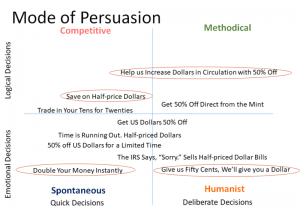Cards are making ads more interactive and engaging, and now they’re moving beyond the big social networks.

In-stream native advertising is thriving with the rise of mobile, but it’s cards that will keep propelling growth in ad spend. Cards have changed the way we experience digital content, and now they are transforming the way we experience and interact with digital advertising. And, as YouTube is demonstrating, ad cards aren’t just for in-stream any more; they can be used in video and beyond for branding and performance advertising.
What Are Cards?
Cards are containers that can house just about any type of content, from text to gifs to video to audio and more. They have become a familiar design construct with the rise of mobile, in part, because cards can adapt to suit any size screen. Cards also make content digestible on small screens and are tailor made for our increasingly short attention spans and desire to consume information as quickly as possibly.
Remember when tweets could only be 140 characters of plain old text? Cards allow users to embed images, video, gifs and more in their tweets. Google’s knowledge panels are cards. Google Now is built on cards. Facebook uses cards. YouTube is ditching video annotations in favor of cards in videos. Pinterest, Tumblr, Instagram are based on cards as are scores of other social sites, messaging apps, media sites and more. (Speaking of Pinterest, there are many boards dedicated to card UI design.)

Google Now cards now show alerts for public transportation.
Cards Are Transforming In-Stream Advertising
Now it’s advertising’s turn to reap the benefits of cards. When we talk about in-stream native ads what we mean are ads that take on the look and feel of the content around them and flow directly in the content stream. Cards make it possible for users to experience, interact with and take action on advertisers’ content, typically without leaving that native environment.
Here are just a few examples of ways cards are transforming digital advertising. Twitter was the first to tout the use of cards in ads. Advertisers can use Twitter cards to generate leads, promote videos, drive app installs or, yes, drive visitors directly to their sites. In the tweet below, users can sign up for a WebEx demo in just two clicks. The email associated with the users’ Twitter account will flow straight into WebEx’s CRM for followup.

On Pinterest, users can click on promoted pins to view additional images while staying within the original stream like this Nasty Gal example.

YouTube has now brought its new card functionality to skippable pre-roll ads on the platform. And last month, YouTube announced a new version of its ad cards that will power Google Shopping ads in retailer’s video ads.

Google debuts an extension of product listing ads in search with TrueView for Shopping ads on YouTube.
A recent Facebook iteration brought image carousels to ads for app installs and engagement ads.

And, of course, the next big push is commerce in ads. Is there a platform left that doesn’t have a buy button in some test phase? This is all largely card based.
Ad Cards Are Moving Beyond The Big Social Networks
What about ad cards on the wider ecosystem of sites and apps? They are coming there, too.
Twitter is testing syndication of promoted tweets to third-party sites, starting with Flipboard and Yahoo Japan.
Sharethrough, a native ad exchange and supply side platform, added support for cards in native ads across it’s publisher network last December.
Here’s an example of a Sharethrough ad card from Ford on the Men’s Health mobile site. Clicking on the ad brings up an infographic promoted by Ford, but keeps the user on the site. Users can share the content displayed in the cards with others on social or email it right from the card.

Sharethrough’s native ad cards enable Ford to promote an infographic within an ad on Men’s Health.
Advertisers can also extend their content marketing on other networks including Twitter, Facebook, Pinterest, YouTube, Instagram, Tumblr, Etsy, Kickstart, Soundcloud across the exchange via more than 20 ad cards offered by Sharethrough.
Cards Are Changing Users’ Expectations of Digital Advertising
We all know about banner blindness. Native in-stream ads are supposed to be the great elixir. But cards are what take user experience and engagement to the next level.
They are also raising the bar for what users will just come to expect from digital ads — that they are relevant, engaging and easy, easy, easy. Why make users go to a landing page to fill out a registration form for a webinar when they can simply submit their email to sign up straight from a Twitter lead gen card (that syncs up with your CRM)?
Going further, when I asked how advertisers should be thinking about cards, Chris Schreiber, VP of marketing and communications at Sharethrough, made a point of highlighting speed: (bolding mine)
“An advertiser has a couple new core responsibilities in the mobile-first world: Serve your content in a way that is visually optimized for the mobile experience and make sure it loads as fast as possible. …Regarding speed, shaving milliseconds off load time can make a huge difference in whether an audience will stick around to ever see your creative. Since cards do not require a link out or the need to load a full web page, they are the fastest native ad experience available.”
Cards for ads are still in their relative infancy and just starting to make their mark on the greater web and app universe. There’s lots more to come.
(Some images used under license from Shutterstock.com.)
Marketing Land – Internet Marketing News, Strategies & Tips
(197)








